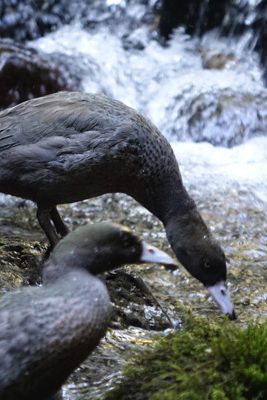The local whio population on Mt Taranaki was designated ‘functionally extinct’ by 1945 due to predation by stoats and rats.
However a predator programme now covering 10,600 ha of the park was started in 2003. With a lot of hard work by DOC, the Central North Island Blue Duck Trust and Whio Forever, another 10 whio were released onto rivers in early 2018.
The region have two conservation dogs – Tai and Marti. Both, along with their rangers help to locate whio in the region. As a result in early 2018, both helped to locate a record number of 64 whio chicks on eight monitored rivers. Additional monitoring has indicated 28 whio pairs. Of those birds, 71% were successful in breeding with an incredible fledgling rate of 84%.
Within 10 years the Taranaki Mounga project plans to increase the number to 56 breeding pairs. A population with 50 breeding pairs is considered to be a secure, viable population.
The first successful breeding was recorded in 2005 and the population has been reintroduced using birds reared in captivity, boosted by WHIONE (Whio Operation Nest Egg) and the survival of wild chicks from successful breeding seasons.
Whio are the only New Zealand duck that lives only in clean, fast flowing rivers and are well adapted to their environment, negotiating the rapids with skills that kayakers would envy. The presence of whio is an indicator of a river’s health. Unlike most ducks whio feed on the larvae and flying stages of aquatic insects such as caddis fly, stonefly and mayfly.
Did you know
- Stoats are the whio’s number one predator
- During the late summer moult period whio are flightless, making them even more vulnerable to attacks
- There are less than 3000 whio left in the world
- Whio feature on the NZ $10 note

